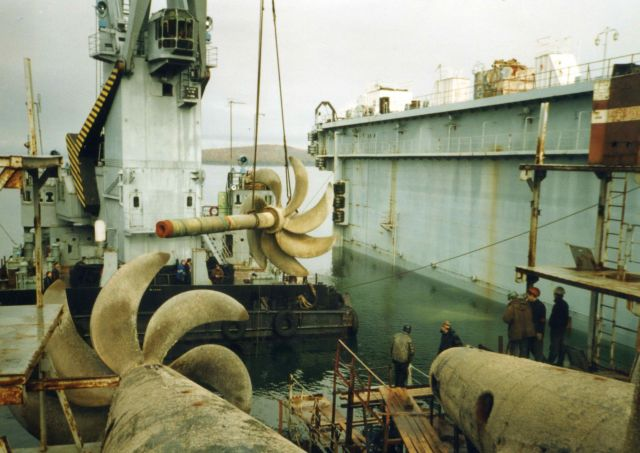@Saturnax1
Project 949A Antey/Oscar II-class SSGN "Orel" (K-226) in a drydock. Note the hollow propeller shaft.
Following is a thread about this particular boat and the massive issues she faced with her shafts.


"Orel" (K-226) propeller shafts were initially made of shorter hollow shafts coupled together with bolts & couplings.
The inside was filled with fine quartz sand - the reason for the hollow shaft was it was easier to manufacture, lighter & cheaper than solid shaft.
Hollow propeller shafts filled with fine sand also help to dampen vibrations & noise. Alas, this wasn't the case for "Orel".
One of the prerequisites for the hollow shafts to function as designed was the use of lightweight propellers, but the technology to manufacture such propellers was not available shortly after the Soviet Union collapsed in the late 1991, so "Orel" was launched in 1992 with a new lightweight & hollow shafts, but with the old and heavy propellers.
The initial sound and performance tests confirmed the propulsion was working as designed and expected, but the first problems appeared almost immediately after "Orel" was commissioned on 30 December 1992 into the Russian Navy Northern Fleet.
Both shafts began to show abnormal deformations under increased loads at the support points & inevitably began to rub against the shaft tunnels.
With the increased speed the noise of the shafts increased as well up to a point, when Orel's own extreme noise completely drowned out the noise of the underwater environment, rendering her sonar suite pretty much useless at higher speeds.
"Orel" was soon known to the Western submarines as "The Roaring Cow" as she was routinely rattling her shafts across the entire Barents Sea.
Defective shafts forced the command of the Northern Fleet to limit "Orel" activities & she completed just 2 patrols in 1995 & 1996.
Due to the characteristic noise she was routinely tracked by the Los Angeles & Trafalgar-class submarines & further patrols were cancelled.
Naval engineers tried to solve the problem, but calculations showed the only solution would be a replacement of both faulty shafts - the issue was the production of the shafts at the Barrikady plant in Volgograd was already suspended and there were no spares available.
In 2001 it was decided to salvage the solid propeller shafts from the ill-fated sister boat "Kursk" (K-141), that sank in an accident on 12 August 2000 in the Barents Sea.
The replacement took place during a repair period between 2003-2004 at SEVMASH Shipyard.
This, however, solved the noise issue just partially, as the old rattling shafts already deformed the shaft tunnels within the hull to such an extent, that the submarine continued to emit extreme noises even with the "new" shafts from "Kursk".
The noise problem got even worse in 2004, when "Orel" suffered an explosion of the aft trim tank while underway, causing a significant damage to the 9th (out of 10 total) compartment and the already damaged shaft tunnels.
After all these issues Russian MoD finally decided to conduct a modernization in 2013, lasting from 2014-2016 - it included reactors refueling, electronics & weapons upgrades as well as repairs of the damaged shaft tunnels & replacement of the "Kursk" shafts with new ones.
"Orel" returned back to the Northern Fleet in the late 2016 and remains in active duty based at Zapadnaya Litsa Submarine Base, Murmansk.
Source: https://iz.ru/news/538511







